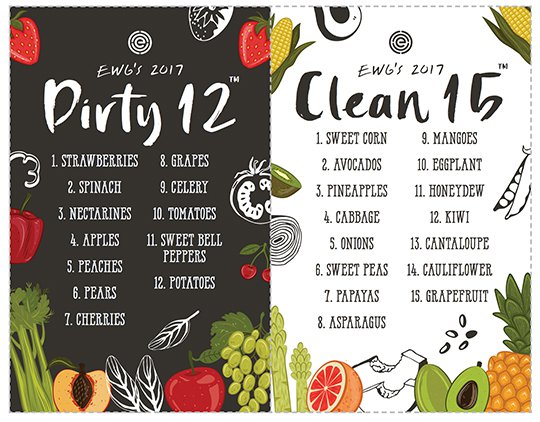The annual Shopper’s Guide to Pesticides helps you navigate the produce section at the grocery store with confidence.
We’re lucky that organic produce is getting easier to find in our local stores. But having more choice creates a bit of a dilemma: should we buy only organic produce – a more expensive option – or pick and choose what we do and don’t buy organic?
Here’s the guide that makes it easy to choose…
Environmental Working Group (EWG) has released its annual Shopper’s Guide to Pesticides, a consumer-friendly report that lists the common produce that reaches our tables with the highest pesticide residue and the produce with little or no pesticide residue. Dubbed the Dirty Dozen and the Clean Fifteen, these lists make it easier to manage your grocery budget in the produce section of the grocery store.
The report is based on an analysis of data gathered by the US Department of Agriculture and the Food and Drug Administration and covers the 48 most commonly consumed fruits and vegetables. For this year’s report EWG sifted through 36,000 samples. All produce was analyzed according to how it is usually consumed. Bananas are peeled, apples are washed…
The goal of the report is to help shoppers navigate the produce section at the grocery store in a way that’s best for our families and our budgets.
The Clean Fifteen (produce with little or no pesticide residue): sweet corn, avocados, pineapples, cabbage, onions, frozen sweet peas, papayas, asparagus, mangoes, eggplant, honeydew melon, kiwis, cantaloupe, cauliflower and grapefruit. According to the report, more than 80 percent of pineapples, papayas, asparagus, onions and cabbage had no pesticide residues.
The Dirty Dozen (produce with the highest pesticide residue): strawberries, spinach, nectarines, apples, peaches, pears, cherries, grapes, celery, tomatoes, sweet bell peppers and potatoes.
These foods tested positive for a number of different pesticide residues and contained higher concentrations of pesticides than other produce. Spinach samples had twice as much pesticide residue by weight than any other crop.
How many pesticides do we consumer in a day?The worrisome part of this is that pesticides are approved for use based on individual data. But farmers can use multiple kinds of pesticides on a single crop and there is no research on how these mixtures of pesticides affect us and the environment. There is also no research on how our bodies handle multiple pesticide residues on the fruits and vegetables that we consume each day.
It’s important to remember that children are more susceptible to the toxic effects of pesticide exposure.
If organic isn’t available or just isn’t doable for your family consider eating foods on the Dirty Dozen list less often and spend more of your grocery budget on produce listed on the Clean 15.
Whatever you choose, keep in mind that eating conventionally grown produce is still healthier than avoiding it for fear of pesticides. (Eating more produce on the Clean Fifteen list gives you the best of both worlds.)
Vist www.ewg.org/foodnews for the full report.







